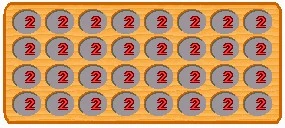| Katra Mpantsaka |
| First Description: André-Jean Dandouau, 1909 |
| Cycles: Two |
| Ranks: Four |
| Sowing: Multiple laps |
| Region: Madagascar |
Katra Mpantsaka (mpantsaka from tsaka "limited") is a mancala game played by the Sakalava people, which occupy the Western edge of the island from Toliara in the south to Sambirano in the north. They speak several dialects of the Malagasy language, which is a branch of the Malayo-polynesian language group derived from the Barito languages spoken in southern Borneo and are numbering approximately 700,000 in population. The game was first described by André-Jean Dandouau (1874-1924) in 1909.
Rules
Katra Mpantsaka is played on a board (variously called fanaovan-katra, fikatrahana, laharana or fanga), which has four rows of eight holes. Each hole has two counters (vary "rice"), usually nickernuts.
Initial Position
The game is played by two persons.
On his turn a player takes the contents of one of his holes and distributes them, one by one, either clockwise or counterclockwise into consecutive holes around the two rows of his own side.
If the last stone falls into a non-empty hole, its contents are distributed in another lap continuing in the same direction as before (unless seeds are captured -- see below).
The first lap must be started with an occupied hole of the inner row unless the inner row is empty.
When the inner row is empty, a player may start from the back row.
The move ends, when the last stone is dropped into an empty hole (mandri "to sleep").
Notes:
- A move can also start with a singleton.
- The direction of sowing may not be changed during a turn.
If the last stone falls into an occupied hole of the inner row and the opposite hole of his opponent's inner row also contains stones, they are captured (homana "to eat"). The contents of both holes, including the seed effecting the capture, are sown in another lap starting in the next hole that follows.
It is permitted to capture many times.
The game ends, when a player has no seeds left.
The player who captured all of the seeds, wins the game. The loser is said to be "lazy (kamo)
Variant
A simplified variant permits starting a move from the back row, even if there are still occupied holes in the inner row.
Discussion
Katra Mpantsaka is very lengthy perhaps because of a missing rule. The game appears to be related to Katro. Probably the contents of the backrow are captured too, if the opponent's front row has become empty.
References
- Dandouau, A.-J.
- Jeux Malgaches. In : Bulletin de l'Académie Malgache 1909; 7: 81-97.
Copyright
© Ralf Gering
Under the CC by-sa 2.5 license.
